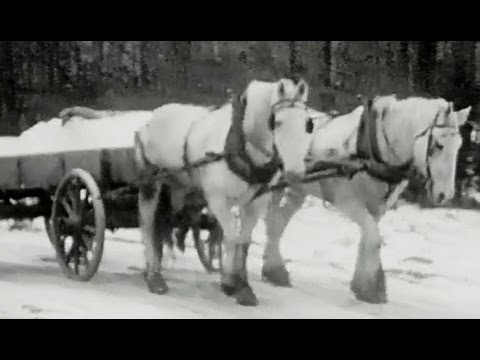more at
Public domain film from the Prelinger Archive, slightly cropped to remove uneven edges, with the aspect ratio corrected, and mild video noise reduction applied.
Ice is water frozen into a solid state. It can appear transparent or opaque bluish-white color…
Ice appears naturally in forms of snowflakes, hail, icicles, ice spikes and candles, glaciers, pack ice, frost, and polar ice caps…
The molecules in solid ice may be arranged in numerous different ways, called phases, depending on the temperature and pressure. Typically, ice is the phase known as ice Ih, which is the most abundant of the varying solid phases on Earth’s surface The most common phase transition to ice Ih occurs when liquid water is cooled below 0°C (273.15K, 32°F) at standard atmospheric pressure. It can also deposit from vapour with no intervening liquid phase, such as in the formation of frost…
Ice has long been valued as a means of cooling. In 400 BC Iran, Persian engineers had already mastered the technique of storing ice in the middle of summer in the desert. The ice was brought in during the winters from nearby mountains in bulk amounts, and stored in specially designed, naturally cooled refrigerators, called yakhchal (meaning ice storage). This was a large underground space (up to 5000 m³) that had thick walls (at least two meters at the base) made of a special mortar called sārooj, composed of sand, clay, egg whites, lime, goat hair, and ash in specific proportions, and which was known to be resistant to heat transfer. This mixture was thought to be completely water impenetrable. The space often had access to a qanat, and often contained a system of windcatchers which could easily bring temperatures inside the space down to frigid levels on summer days. The ice was used to chill treats for royalty.
There were thriving industries in 16/17th century England whereby low lying areas along the Thames estuary were flooded during the winter, and ice harvested in carts and stored inter-seasonally in insulated wooden houses as a provision to an icehouse often located in large country houses, and widely used to keep fish fresh when caught in distant waters. This was allegedly copied by an Englishman who had seen the same activity in China. Ice was imported into England from Norway on a considerable scale as early as 1823.
In the United States, the first cargo of ice was sent from New York City to Charleston, South Carolina in 1799, and by the first half of the 19th century, ice harvesting had become big business. Frederic Tudor, who became known as the “Ice King,” worked on developing better insulation products for the long distance shipment of ice, especially to the tropics; this became known as the ice trade.
Trieste sent ice to Egypt, Corfu, and Zante; Switzerland sent it to France; and Germany sometimes was supplied from Bavarian lakes. Until recently, the Hungarian Parliament building used ice harvested in the winter from Lake Balaton for air conditioning.
Icehouses were used to store ice formed in the winter, to make ice available all year long, and early refrigerators were known as iceboxes, because they had a block of ice in them. In many cities, it was not unusual to have a regular ice delivery service during the summer. The advent of artificial refrigeration technology has since made delivery of ice obsolete.
Ice is still harvested for ice and snow sculpture events. A swing saw is used to get ice for the Harbin International Ice and Snow Sculpture Festival each year from the frozen surface of the Songhua River. Many ice sculptures are made from the ice.
Commercial production
Ice is now produced on an industrial scale, for uses including food storage and processing, chemical manufacturing, concrete mixing and curing, and consumer or packaged ice. Most commercial ice makers produce three basic types of fragmentary ice: flake, tubular and plate, using a variety of techniques. Large batch ice makers can produce up to 75 tons of ice per day.
Ice production is a large business; in 2002, there were 426 commercial ice-making companies in the United States, with a combined value of shipments of $595,487,000…
Pocono Manor Historic District is a national historic district located in Pocono Township and Tobyhanna Township, Monroe County, Pennsylvania. It encompasses 75 contributing buildings, 1 contributing site, 4 contributing structures, and 4 contributing objects on the historic resort of Pocono Manor. The resort community was established in 1902, and includes an Inn, recreational complex, and dependent cottage community. The cottage community was originally developed by Quakers and the cottages reflect popular early-20th century architectural styles including Stick/eastlake, Shingle Style, and Bungalow / American Craftsman….

